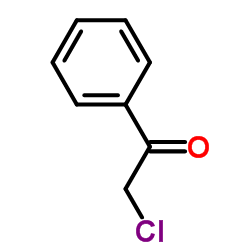2-Chloroacetophenone

2-Chloroacetophenone structure
|
Common Name | 2-Chloroacetophenone | ||
|---|---|---|---|---|
| CAS Number | 532-27-4 | Molecular Weight | 154.594 | |
| Density | 1.2±0.1 g/cm3 | Boiling Point | 244.5±0.0 °C at 760 mmHg | |
| Molecular Formula | C8H7ClO | Melting Point | 54-56 °C(lit.) | |
| MSDS | Chinese USA | Flash Point | 104.8±11.0 °C | |
| Symbol |



GHS05, GHS06, GHS08 |
Signal Word | Danger | |
|
2-Pyridinealdoxime, a new ligand for a Pd-precatalyst: application in solid-phase-assisted Suzuki-Miyaura reaction.
Mol. Divers. 9(4) , 333-9, (2005) The preparation of a new palladium(II) complex with a 2-pyridinealdoxime ligand and its use as a Pd(0) precatalyst in the cross-coupling Suzuki-Miyaura reaction is described. Several concepts for the immobilization of this catalytic system are presented and c... |
|
|
The use of chemical incapacitant sprays: a review.
J. Trauma 52(3) , 595-600, (2002)
|
|
|
Occupational contact dermatitis due to 2-chloracetophenone tear gas.
Br. J. Dermatol. 140(3) , 531-4, (1999) 2-Chloracetophenone (CN) is widely used as tear gas by police and civilians for self-defence. It may affect the eyes, respiratory system and skin, sometimes causing serious injuries. Both irritative and allergic contact dermatitis have been described. We repo... |
|
|
Effect of food seasoning spices mixture on biomarkers of oxidative stress in tissues of fructose-fed insulin-resistant rats.
J. Med. Food 10(1) , 149-53, (2007) High fructose feeding in normal rats induces insulin resistance and also facilitates oxidative damage. The present study examines the effects of a spices mixture (SM) on oxidative stress markers and antioxidant potential in tissues of high fructose-fed insuli... |
|
|
Thermal decomposition studies of riot control agent ω-chloroacetophenone (CN) by pyrolysis-gas chromatography-mass spectrometry.
J. Hazard. Mater. 184(1-3) , 506-14, (2010) Pyrolysis-GC/MS system with on-line micro-furnace was used to make rapid evaluation of ω-chloroacetophenone (CN) decomposition under inert thermal atmospheres. The volatile products evolved during pyrolysis were analyzed by thermal gravimetric analysis (TGA) ... |
|
|
Asymmetric reduction of o-chloroacetophenone with Candida pseudotropicalis 104.
Biotechnol. Prog. 22(5) , 1301-4, (2006) The asymmetric reduction of o-chloroacetophenone 1 with Candida pseudotropicalis 104 produced the corresponding (S)-1-(2-chloro-phenyl)-ethanol 2 with the enantiomeric excess (ee >99%) without addition of any cosolvent. The cell could tolerate high ketone 1 c... |
|
|
An evaluation of the relative potential public health concern for the self-defense spray active ingredients oleoresin capsicum, o-chlorobenzylidene malononitrile, and 2-chloroacetophenone.
Regul Toxicol Pharmacol 36(1) , 1-11, (2002) In 1996, the New York State Department of Health was charged by the State Legislature to develop regulations regarding the types of self-defense spray devices which could lawfully be purchased, possessed, and used in New York State. Prior to this legislation,... |
|
|
Free radical scavenging activity, metal chelation and antioxidant power of some of the Indian spices.
Biofactors 31(3-4) , 219-27, (2007) Food constituents are the major source of various phytochemicals and micronutrients. The importance of these dietary constituents has been stressed in recent years due to their antioxidant and anticarcinogenic potential. Spices used in Indian foods such as cl... |
|
|
Electron transfer compatible molecular design of benzothiophene-acetophenone bichromophores: a theoretical approach.
Spectrochim. Acta. A. Mol. Biomol. Spectrosc. 57(3) , 545-9, (2001) Computational work has been done for a bichromophore (4MBA) comprising a donor 4-methoxy-benzo[b]thiophene (4MBT) and an acceptor molecule p-chloro-acetophenone (pclA) linked together by a HC=CH bond which shows large hyperpolarizability. The charge transfer ... |
|
|
Treatment of capsaicin (Mace?) dermatitis.
Am. J. Emerg. Med. 17(2) , 210-1, (1999)
|